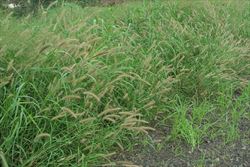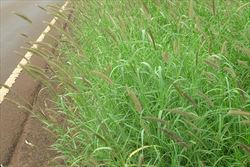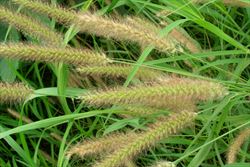Click on images to enlarge

infestation (Photo: Forest and Kim Starr, USGS)

infestation (Photo: Forest and Kim Starr, USGS)

habit (Photo: Forest and Kim Starr, USGS)

habit (Photo: Forest and Kim Starr, USGS)

stems and leaves (Photo: Forest and Kim Starr, USGS)

seed-heads (Photo: Forest and Kim Starr, USGS)

close-up of seed-head (Photo: Forest and Kim Starr, USGS)
Scientific Name
Cenchrus pedicellatus (Trin.) Morrone
Two subspecies are present in Australia:
Cenchrus pedicellatus (Trin.)
Morrone subsp. pedicellatum
Cenchrus pedicellatus subsp. unispiculus (Brunken) Morrone
Synonyms
Pennisetum pedicellatum Trin.
supspecies:
Pennisetum pedicellatum Trin. subsp.
pedicellatum
Pennisetum pedicellatum subsp.
unispiculum Brunken
Family
Gramineae (South Australia)Poaceae (Queensland, New South Wales, the ACT, Victoria, Tasmania, Western Australia and the Northern Territory)
Common Names
annual kyasuwa grass, annual mission grass, Deenanth grass, feather pennisetum, hairy fountain grass, kyasuma grass, kyasuma-grass, kyasumagrass, kayasuwa grass, kyasuwa grass, Nigeria grass
Origin
Native to tropical Africa (i.e. Eritrea, Ethiopia, Sudan, Kenya, Tanzania, northern Cameroon, Benin, Burkina Faso, Ivory Coast, Gambia, Ghana,Guinea, Mali, Mauritania, Niger, Nigeria, Senegal, Togo and Zambia).
Naturalised Distribution
Deenanth grass (Cenchrus pedicellatus) is widely naturalised in northern and eastern Australia. It is also naturalised elsewhere, including in south-eastern USA (i.e. Florida), Hawaii and New Caledonia.
Cenchrus pedicellatus subsp. pedicellatus is naturalised in northern Queensland, northern Western Australia, the northern parts of the Northern Territory, and on Ashmore Reef.
Cenchrus pedicellatus subsp. unispiculus is naturalised in northern and eastern Queensland, in northern Western Australia, and in the northern parts of the Northern Territory.
Notes
Deenanth grass (Cenchrus pedicellatus) is regarded as an environmental weed in the Northern Territory and Western Australia, and as a potential environmental weed in other parts of northern Australia. It was recently listed as an environmental weed in at least one Natural Resource Management region.

